A very nice young man came to see us January 2020. We’ll call him Andrew (not his real name). He had just arrived in the UK, would be staying for a few years and wanted to tour various parts of Yorkshire & beyond. After listening to Andrew’s needs, RCE advised him upon; types of touring bikes, carrying capacities, gears ratios, handlebar shapes, frame materials & geometry, shifters, tyre size & puncture-resistance, etc.
Although Andrew had a budget of about £550.00, it was not enough for his ideal bike! No problem – RCE advised him on alternative shops and off he went – we never thought we’d see him again.
Lo and behold, a couple or three weeks later, he comes smiling into the shop with a possible candidate bike:
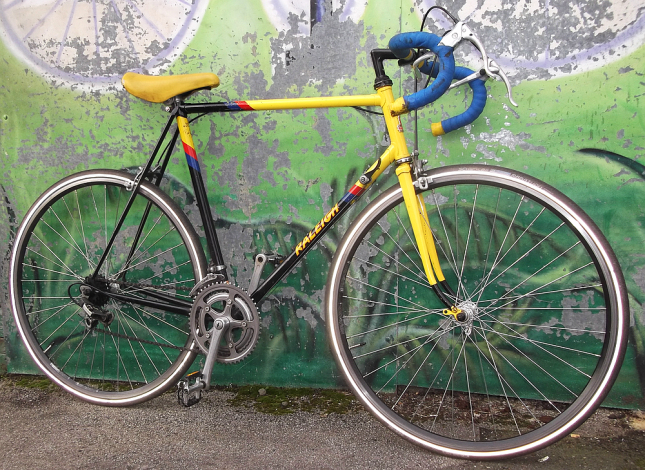
Andrew: “Thanks for all that info you gave me last time – it was really useful. OK, I’ve got this bike. I’ll need it looked at in detailed, a rear pannier rack, mudguards, bottle & holder, high-puncture-resistance tyres, and whatever you can advise me on. I have a £400.00 budget. What can you do for me?”.
RCE: “We’d spent a lot of time with you last time – without any recompense – that’s not an issue. Therefore, a) Thank You for acknowledging our help, b) Thank You for coming back and c) Thank You for the challenge. Looking forwards to it!”.
Andrew: “I wouldn’t have gone anywhere else. You know what you’re talking about and I trust you.”.
After a few more reciprocated ‘Thank You’s we agreed to carry out a detailed assessment (£12.50) of the candidate bike afore pumping a lot of £££s into the project.
Our assessment indicated that the following needed attention:
- Headset (bearing where the forks go into the frame) – more grease,
- Bottom bracket (bearing between the pedals) – take up wear’n’tear,
- Wheels – re-tension and true,
- Wheel hubs – take up wear,
- Brake callipers – clean and take up wear on arms,
- Gear systems (front & rear) – the bike came with gear ratios for racing – would need to change that if Andrew wanted to get up all the hill in Yorkshire and maintain a high speed on the levels and downhills,
- Gear shifting – the existing shifters we’re on the downtube – not ideal, preferred position was shifting from the handle bars,
- Tyres – the bike already had high-puncture-resistant 700x25C Schwalbe Marathons on – preferred choice was for 28C tyres, and,
- Rack – being a vintage racing bike it does not have any upper-fastening facilities.
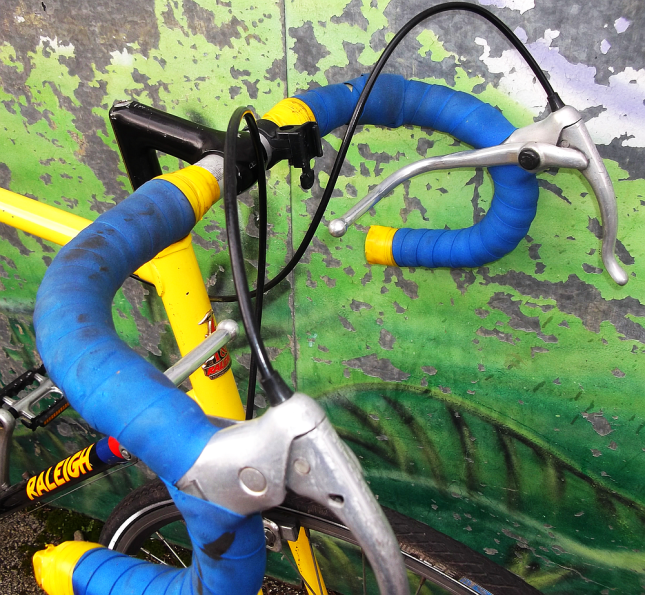
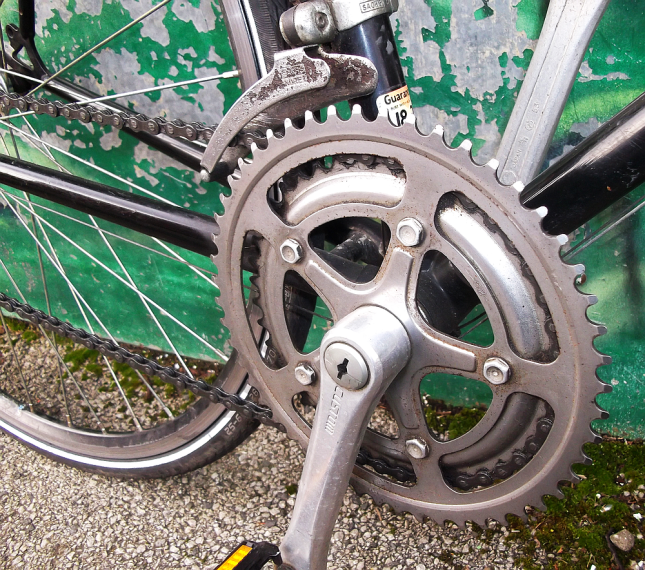
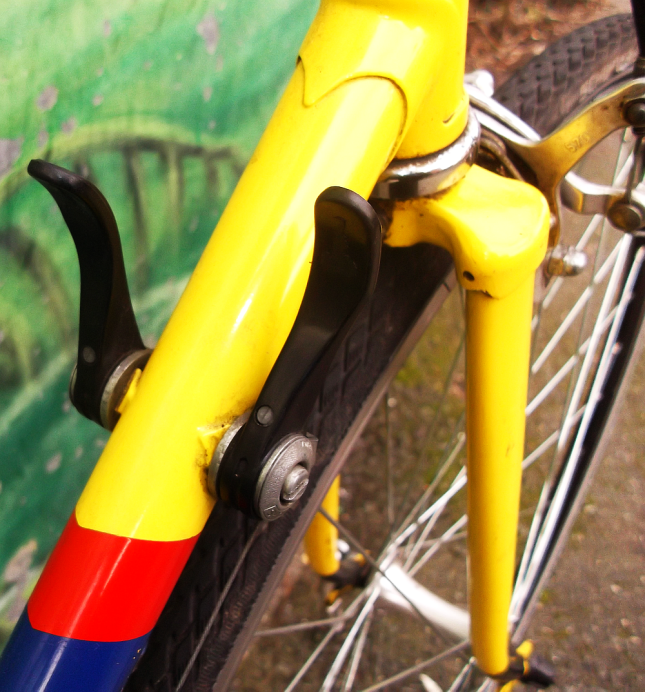
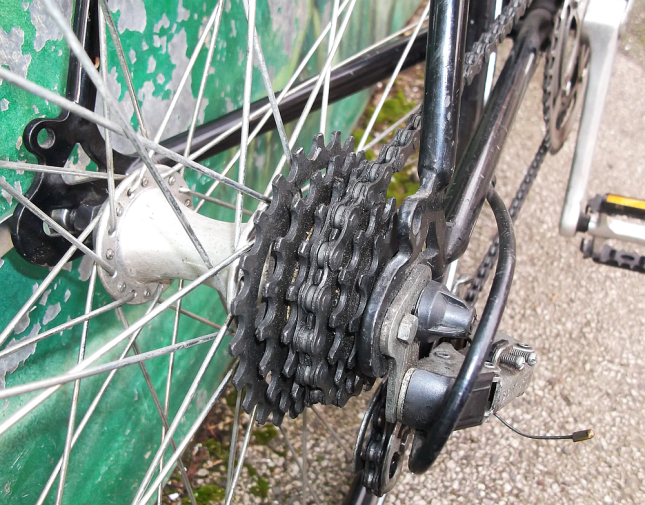
Of prime import was the gear ratios. The chainset (front cogs) was a ‘double’ with a 53T outer and a 48T inner, and, the freewheel (rear cogs) was 6-speed with 23T low gears and a 14T high gear. This gives:
- lowest gear = 2.09 (48 divided by 23),
- highest ratio = 3.79 (53 divided by 14), and
- overall ratio = 181% (3.79 divided by 2.09). When we were kids, those ratios used to kill us – especially in our Pennines town.
As Andrew wanted braking & shifting from the handlebars, the only reasonable option was for Shimano Tourney Sti (Shimano Total Integration) brake/shifters. Unfortunately, these are only available in 7-speed (for, either a double or a triple chainset) and only for the appropriate 7-speed freewheels (unlike the one provided on the bike (a 1989 Sach Huret model – different spacing between sprockets). Further, even within Shimano’s range 6 and 7-speed, shifter cable-pull ratios and freewheel sprocket spacing are different – therefore, the two are NOT compatible. Meaning, that only a Shimano (or compatible) 7-speed freewheel could be used. Being wider than a 6-speed freewheel, question: would there be enough space on the rear spindle for a 7-speed one. And if not, what could we do about it? A test-fitting of a Shimano 7-speed freewheel 14/28T proved successful – without having to piss-about changing the rear axle.
Next task – the chainset. One cannot throw on any old chainset onto a square-taper bottom bracket. Some will sit too close the frame – perhaps hitting the frame or not allowing the front dérailleur (FD) to shift the the smallest sprocket. Counterwise, some will sit too far away from the frame and not allow the FD to shift to the biggest sprocket.
Another chainset consideration was that of using a double or a triple one. A triple would offer very wide ratios but require changing the FD for a triple-compatible model (and more £££s).
Final chainset consideration was that of crank length (the distance from the centre to where the pedals are). The existing chainset was 165mm – not ideal for Andrew’s leg length. A minimum length of 170mm was required.
So, what do do? Well, being the best bike workshop, this side of Nagasaki, RCE had over a 100 chainsets to select from. Narrowing down to 7-speed options, with (at least) a 170mm crank length) and with the correct profile to sit on the BB, narrowed down our options. After calculating gear ratios a further discussion with Andrew, we arrived upon a solution – 170mm, 50/42T double (a lightly-used Sakae with replaceable sprockets. The new gear rations:
- lowest gear = 1.5 (42 divided by 28) (previously 2.09),
- highest gear = 3.78 (50 divided by 14) (previously 3.79), and
- overall ration of 230% (3.78 divided by 1.5) (previously 181%).
So, RCE managed to keep his highest gears ratio similar AND reduce the lowest gear ratio by a whopping 28% (that should get Andrew up all Yorkshire hills). A further 3% can be garnered with the extended crank length.
Gee, we’re good!
The existing rear dérailleur (RD) would not cope with a 28T freewheel and the replacement chainset ratio. A Shimano Tourney, correct cabling and special ferrules (for older frames) would be require.
Another major concern was the tyres – would a 28mm wide fit on the wheels, would the wheel sit the frame and then, can we then fit full mudguards? Being a proper vintage racer, this frame’s clearances were narrowly limited. Test fitting of 28C tyres and mudguards proved unsuccessful! (A lot or cursing ensued). The 25C tyres would stay and 28mm wide mudguards would (just) work.
But wait, we haven’t even priced out the project yet! Adding up the price of new components and our efforts gave us a figure of over £500.00 – beyond Andrew’s budget!
Even the option of lightly-used second-hand Tourney Stis and a second-hand rack still didn’t get to the £400.00 mark!
Only one thing to do – DISCOUNTS! Dealing with someone so nice, who was also buying all components from RCE, we were glad to make it affordable for Andrew!
Here’s the completed project after carrying the last 6 steps:
- carry out works,
- get Andrew back into the workshop to finalise the exact positions of the Stis, handlebars and stem,
- fit bartape,
- advise Andrew on correct use of gears, loading of rack, basic maintenance, security, etc.,
- take our payment, and
- get the bike back in after 50 to 100miles for final tweaking.
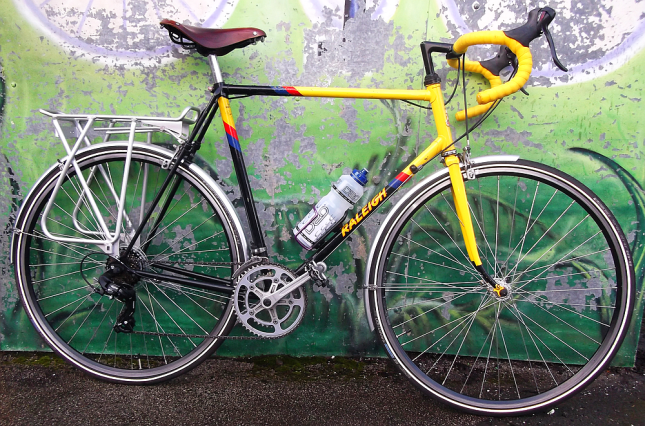
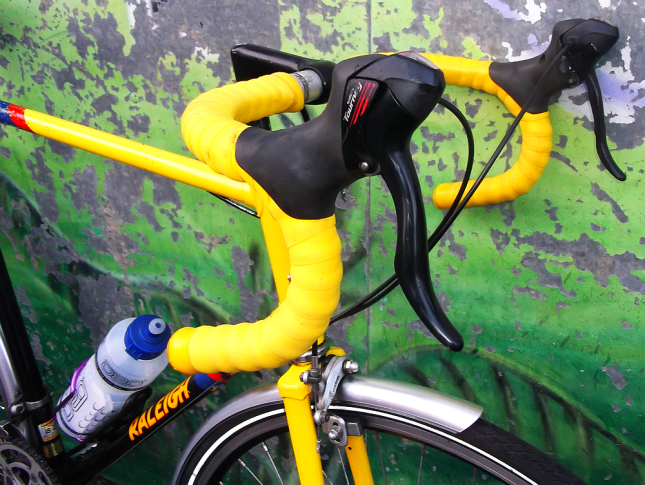
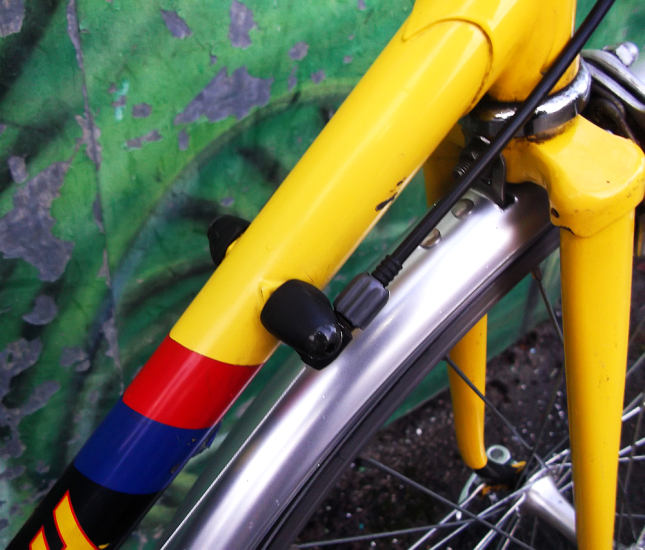
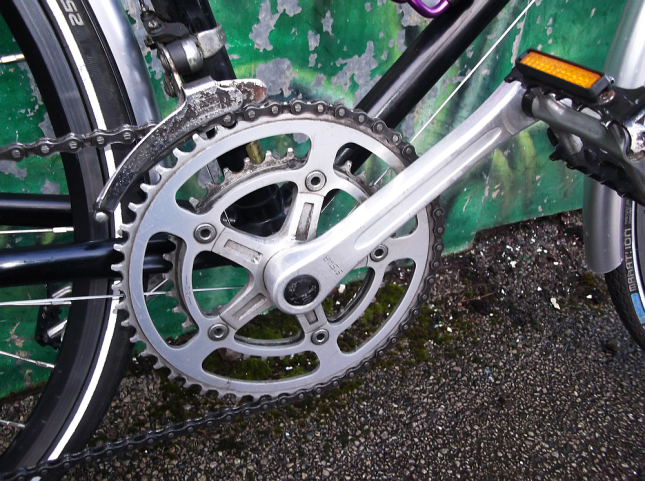
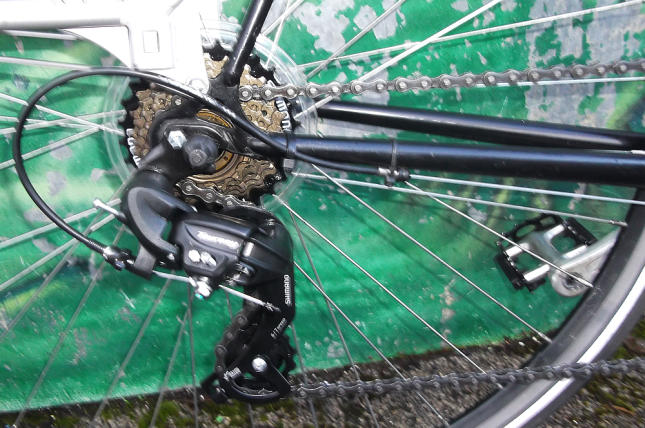
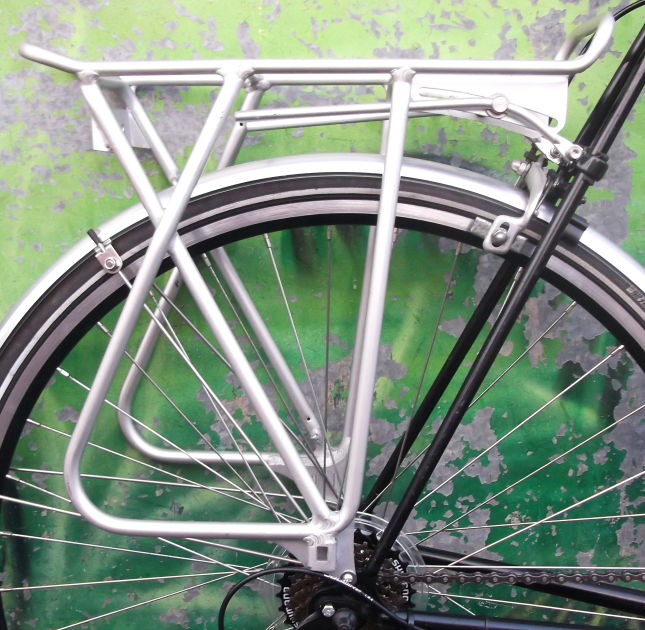
Although projects such as this one is just-another-day to us, we were proud-as-punch with our results. Though not as much as Andrew!
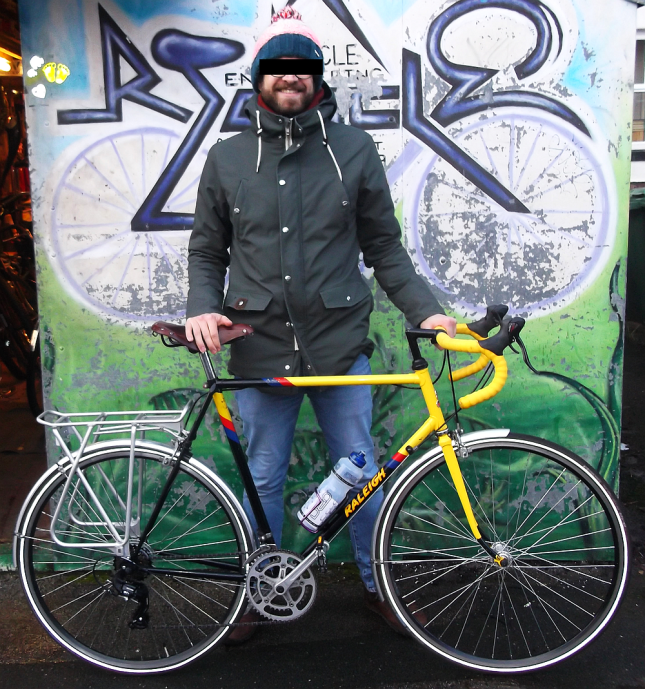
Re-Cycle Engineering – not like the others!
Lilliputians riding tricycles?
How NOT to transport a pizza on a bike.
And the, some freaking idiot invented the “lady’s bicycle”.
Finally, a practical guide for roadside wildflower viewing. Made us chuckle.
Video: watch it all, cyclists may be interested at 4:07.
How many grammar nazis does it take to change a lightbulb?
“I wanna play cricket on the green
Ride my bike across the street
Cut myself and see my blood
I wanna come home all covered in mud”
and, finally
Live version with Lou Reed:
